On the morning of TED2017’s first day, our TED Fellows continue to blow minds in session 2 of the TED Fellows Talks — including a science demo featuring carnivorous plants, some gorgeous cultural mashups, and an introduction to the fish who won evolution.
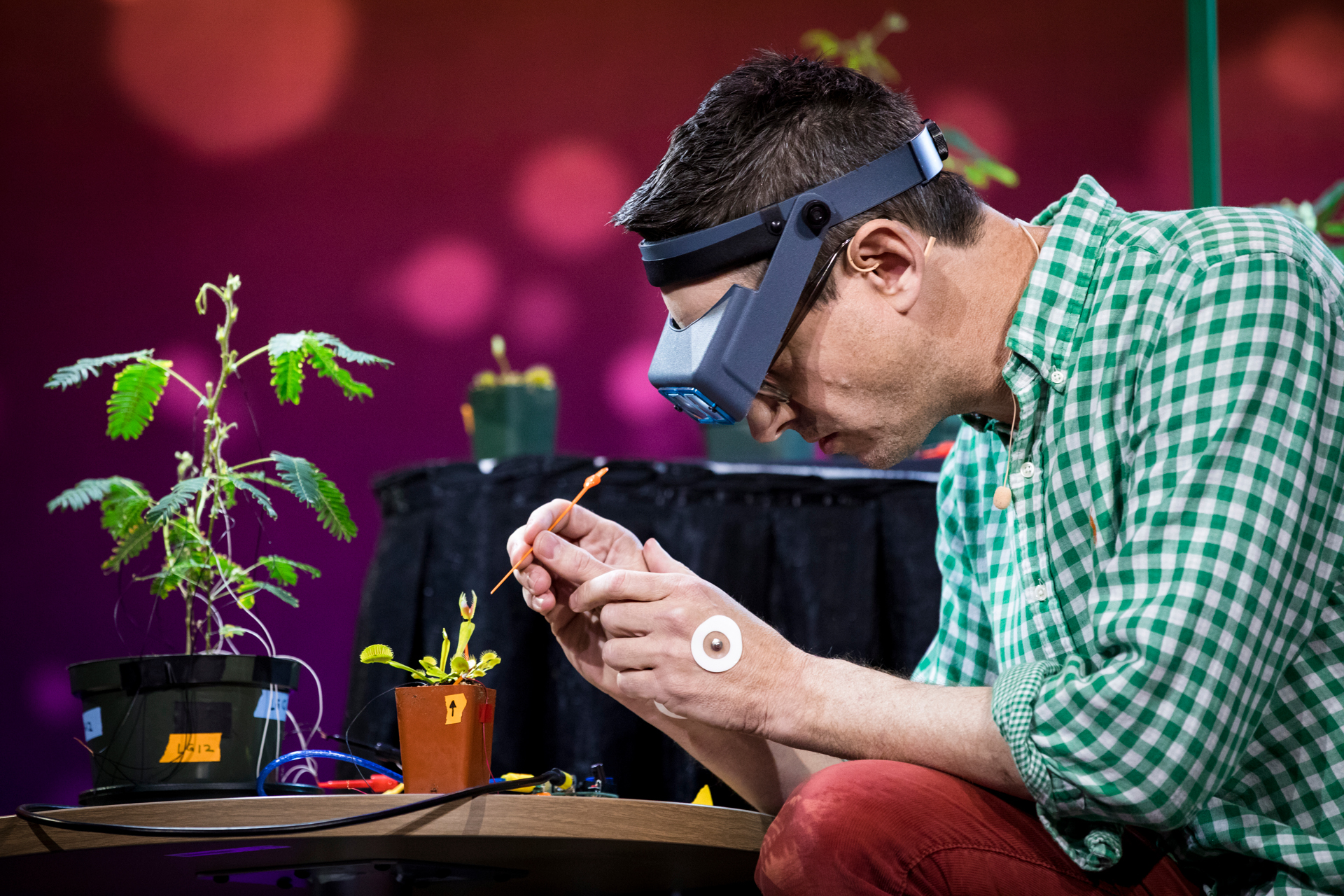
From left, a sensitive plant (Mimosa pudica), a Venus flytrap (Dionaea muscipula), and neuroscientist Greg Gage. All three of these creatures use electrical impulses to convey information within their bodies, but Greg Gage is the one who gets to explain that. He speaks at TED2017, April 24, 2017, Vancouver, BC, Canada. Photo: Ryan Lash / TED
Do plants have brains? Well, no, but they’re certainly not dumb. And, in the case of the carnivorous Venus fly trap, plants not only move – and quickly – but can count. Neuroscientist and electrophysiologist Greg Gage takes the stage to demonstrate that plants, like animals, can use electrical signals to convey information and allow quick responses. He shows the action potential of Mimosa pudica, a plant whose leaves curl if you touch them, and whose branches fall if you tap them, possibly an insect-deterring response. The lesson? What muscles do for animals, water cells do for plants, receiving electrical signals that prompt movement. Next, a Venus fly trap. Gage touches the sensor hair inside the plant’s trap, its action potential spikes onscreen – yet it doesn’t close. Why? It takes a lot of energy for the plant to move, so it wants to be sure there’s a food in there before it invests. The plant “counts” 20 seconds, and will only snap shut only if it gets stimulated again within that time.
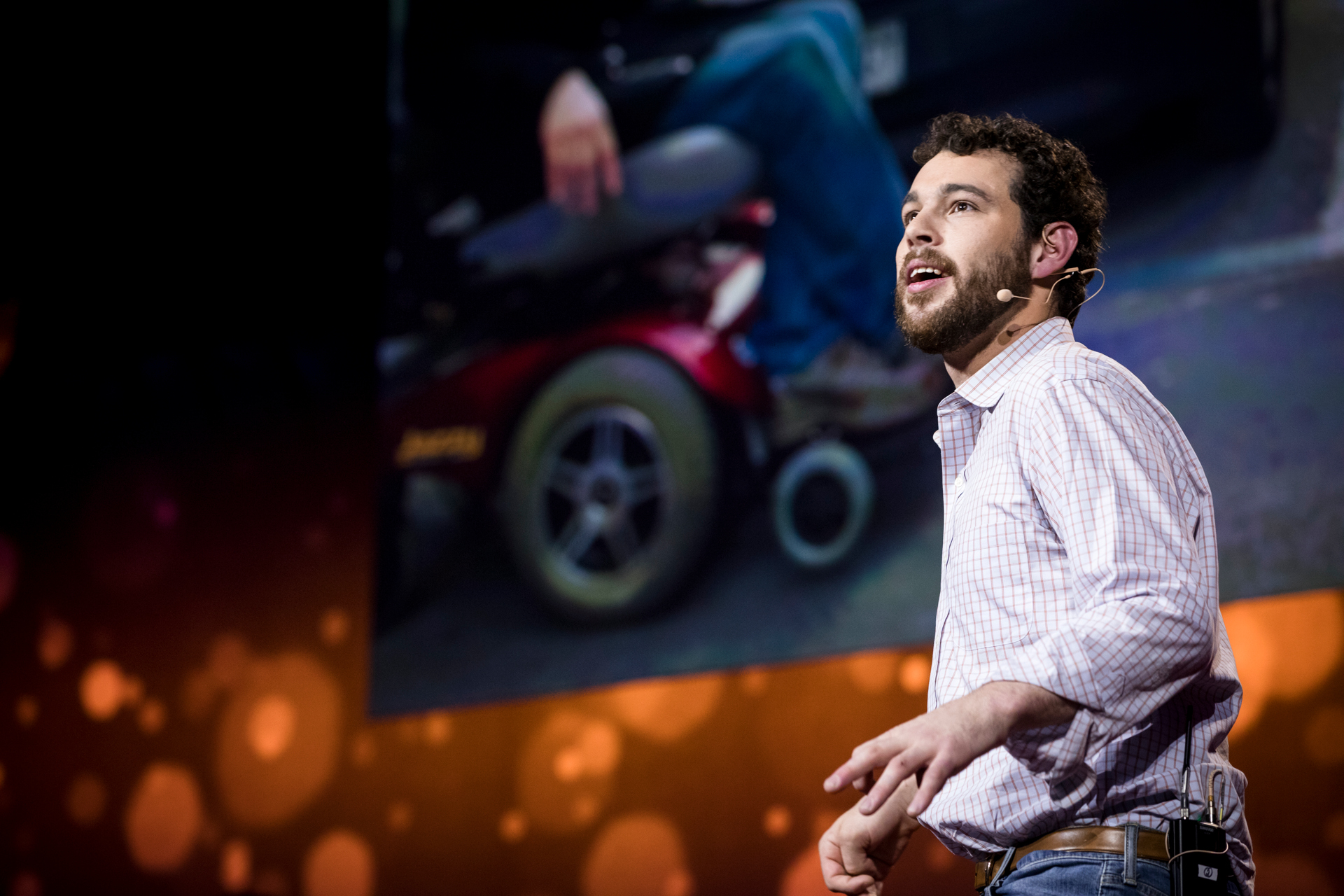
Reid Davenport wants more people with disabilities to make films — to make sure their voices and experiences get heard. He speaks at TED2017, April 24, 2017, Vancouver, BC, Canada. Photo: Ryan Lash / TED
When filmmaker Reid Davenport was denied participation in a study-abroad program due to his cerebral palsy, he spent three weeks exploring Europe instead, documenting his experiences with inaccessibility along the way. It turned out to be exhausting, but when Wheelchair Diaries finally screened, he knew it was worth the effort to help audiences empathize. Partly because of the physical rigors of filmmaking, people with disabilities are underrepresented in the industry, says Davenport. “But the different physicalities of people with disabilities are precisely why we need more filmmakers with disabilities.” He encourages doing whatever is necessary – even taping camera phones to wheelchairs – to imprint our unique physicality on screens big and small to make their voices and experiences heard.
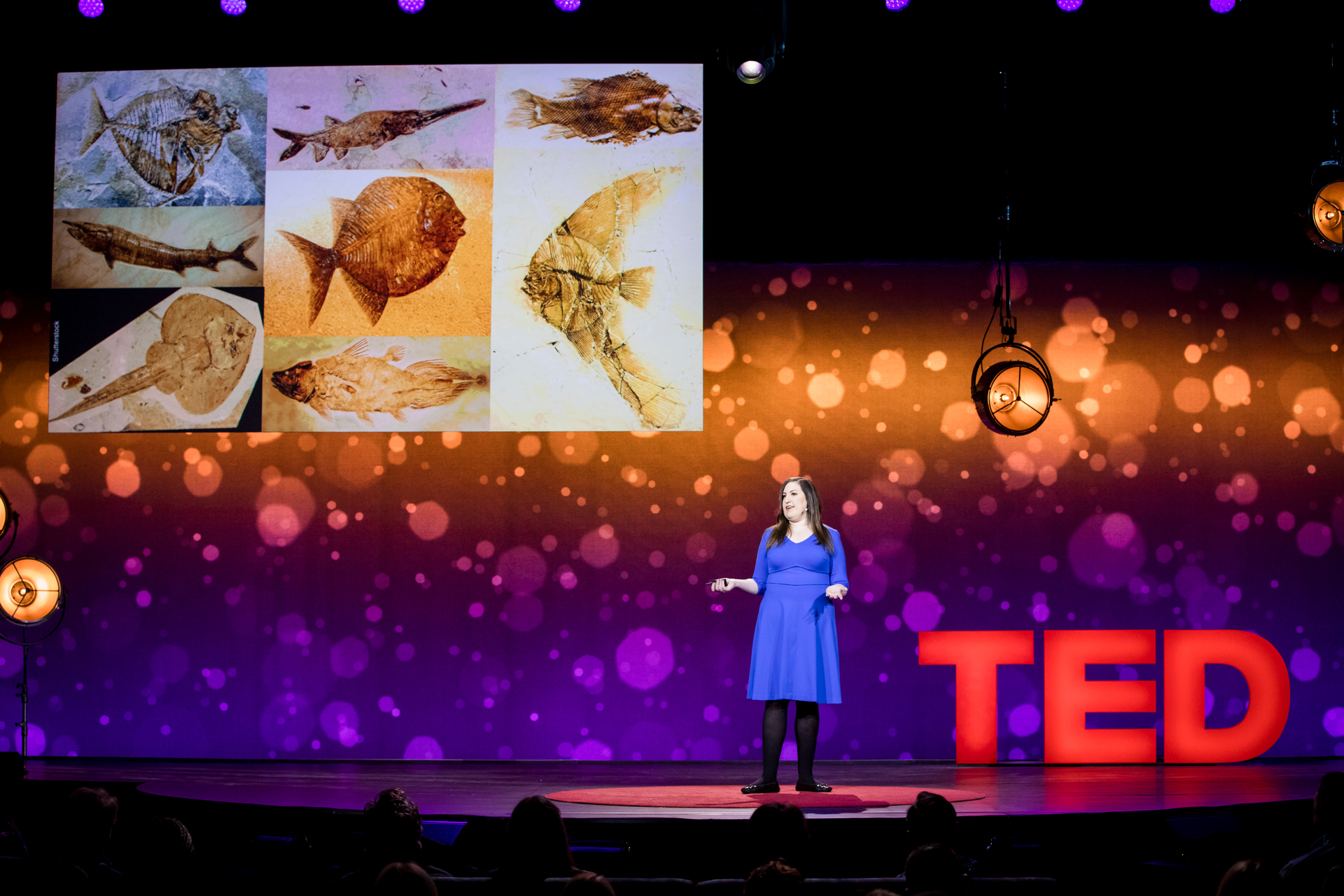
Fish paleobiologist Lauren Sallan dives into hundreds of billions of years’ worth of fish fossils to follow the trail of evolution. She speaks at TED2017, April 24, 2017, Vancouver, BC, Canada. Photo: Ryan Lash / TED
“You are here because of golden opportunities made possible by mass extinction,” says Lauren Sallan, fish paleobiologist and assistant professor at the University of Pennsylvania. She studies the fossil record to figure out why some species live and other species lose — or, as she wryly puts it, she knows how to make dead fishes talk. At her lab, she combs a 500-million-year database for evolutionary patterns, looking for major pathways of change throughout time. Take the Devonian period, some 360 million years ago. The ecosystem at the time was a crowded one in which strange creatures like armored predators and crablike fishes dominated. Meanwhile, our four-legged ancestors, the tetrapods, were struggling in the tropical river plains. Then there was a huge extinction event and 97% of species died. “What counted was what survivors did over the next several million years in that devastated world,” notes Sallan. “The former overlords should have had an advantage, yet they merely persisted for a while declining without innovating, becoming living fossils. They were too stuck in their ways and are now largely forgotten.” See a gallery from Lauren’s talk >>

In her music and film, Kayla Briët works to tell the stories of her heritage and her own identity. She speaks at TED2017, April 24, 2017, Vancouver, BC, Canada. Photo: Ryan Lash / TED
Kayla Briët was raised in multigenerational home of extended family. Her mother is Chinese and Dutch Indonesian, her father Ojibwe and an enrolled tribal member of the Prairie Band Potawatomi tribe. Being surrounded by this mix of cultures was her norm – but also confusing, she says. Seeking her own voice in the mix, she never felt “enough,” never felt fully a part of any community. She found her voice in music, making soundscapes as sonic portals of memory and emotion. Briët makes films to add a visual layer to her explorations – her latest documentary, Smoke That Travels, addresses her fear that her Native heritage will be forgotten due to forced assimilation and the loss of language. Now, wherever she travels, she meets indigenous people involved in similar struggles to preserve language and culture. “We are all storytellers,” Briët says. “Reclaiming our narratives – and listening to others – can create a portal that can transcend time itself.”
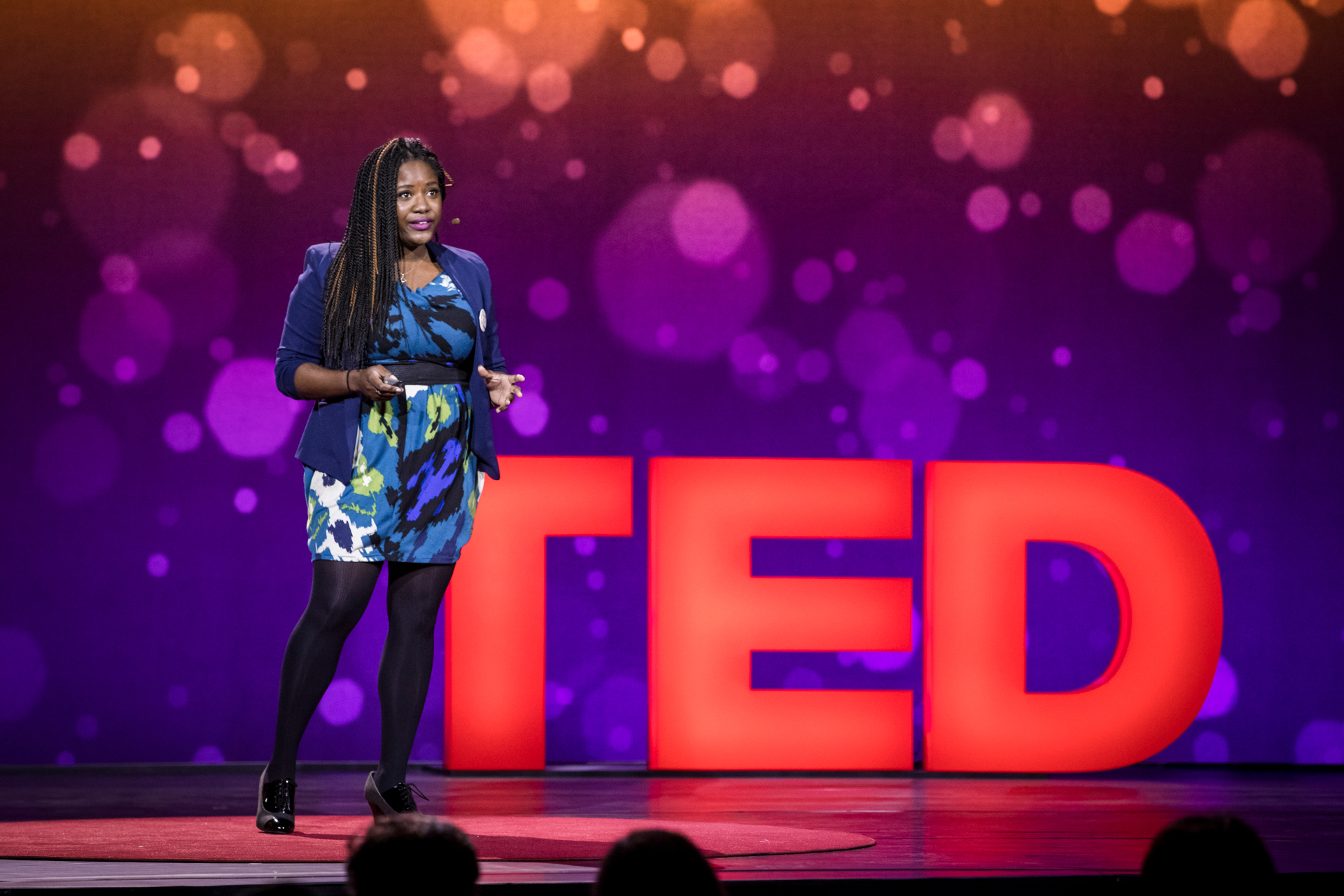
Biomedical engineer Elizabeth Wayne is working on a new way to bring cancer drugs to the places they need to go. She speaks at TED2017, April 24, 2017, Vancouver, BC, Canada. Photo: Ryan Lash / TED
We have the drugs to treat cancer — what we need is a better drug delivery system, one that doesn’t bypass cancer to kill healthy cells, or allow loss through the body’s natural processes. Biomedical engineer Elizabeth Wayne had an idea: immune cells already know how to travel to places of disease in the body. Why not add an extra passenger – a drug that can kill cancer? In her lab, Wayne creates nanoparticles out of the same materials as our cell membranes, and inserts a payload of Trial, a drug that kills cancer but not healthy cells. These nanoparticles are injected into the bloodstream where they bind with immune cells, which carry the medicine to cancer cells. In her animal tests, this method killed more than 75 percent of the cancer cells, compared to 25 percent in control tests. This is great news for cancer research, but what’s even more exciting: using different combinations of medicines and molecules, this immune-cell delivery could someday be applied to any disease where immune cells are present – from unclogging artieries or to delivering wound-healing agents, or crossing blood brain barrier to treat Parkinson’s.
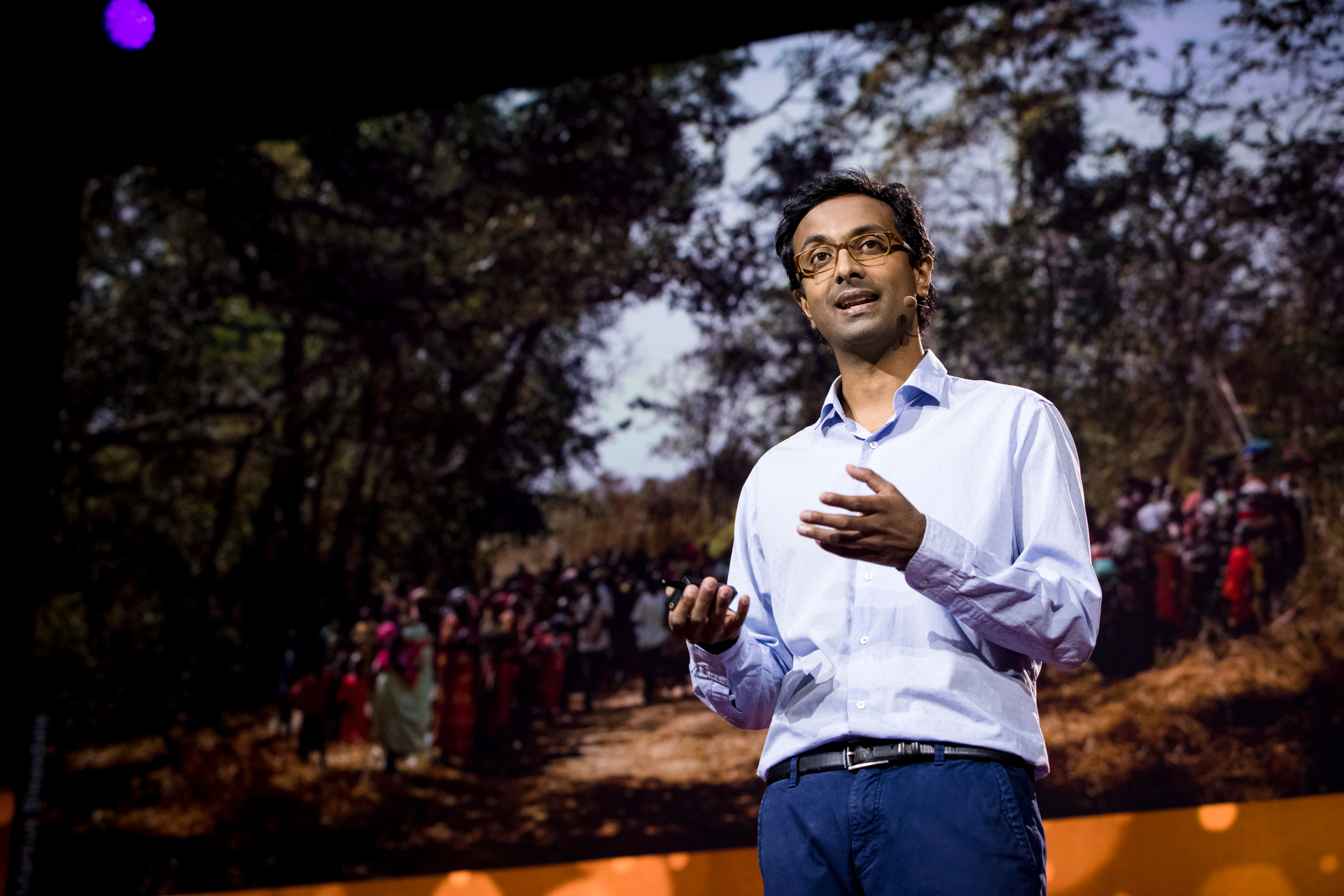
When journalist Anjan Sundaram reported on the war in the Central African Republic, he was struck by the silence around the conflict. The first question locals would ask him: “Do people know?” He tells their story at TED2017, April 24, 2017, Vancouver, BC, Canada. Photo: Ryan Lash / TED
Three years ago, journalist Anjan Sundaram traveled to the Central African Republic to report on its ongoing war. When he arrived there, he realized that he had come at a terrible moment: “I was witnessing the slow preparation for ethnic cleansing.” The Central African Republic, a nation of five million citizens, has experienced waves of violence since French colonial rule ended in 1960. When Sundaram was there, the conflict was between the minority Muslim government and citizen militias, who were mostly Christian. As he journeyed around the country via motorcycle, he was struck by the silence and desolation … and gradually realized, he says, “in a war zone, you know that you are near the killing when people have left.” Many residents had fled into the jungles, and when some emerged to speak to Sundaram, their first question to him was “Do people know?” He says, “The question surprised me. Their children were hungry and sick, but they didn’t ask for food and medicine. I became determined that this moment in their lives should not be forgotten.” The events that Sundaram experienced there still haunt him today. He continues to ask himself, “Why did I go there? Why did I put myself at risk?” His answer: “I do this work because I feel that ignored people in all our communities tell us something important about who we are.”
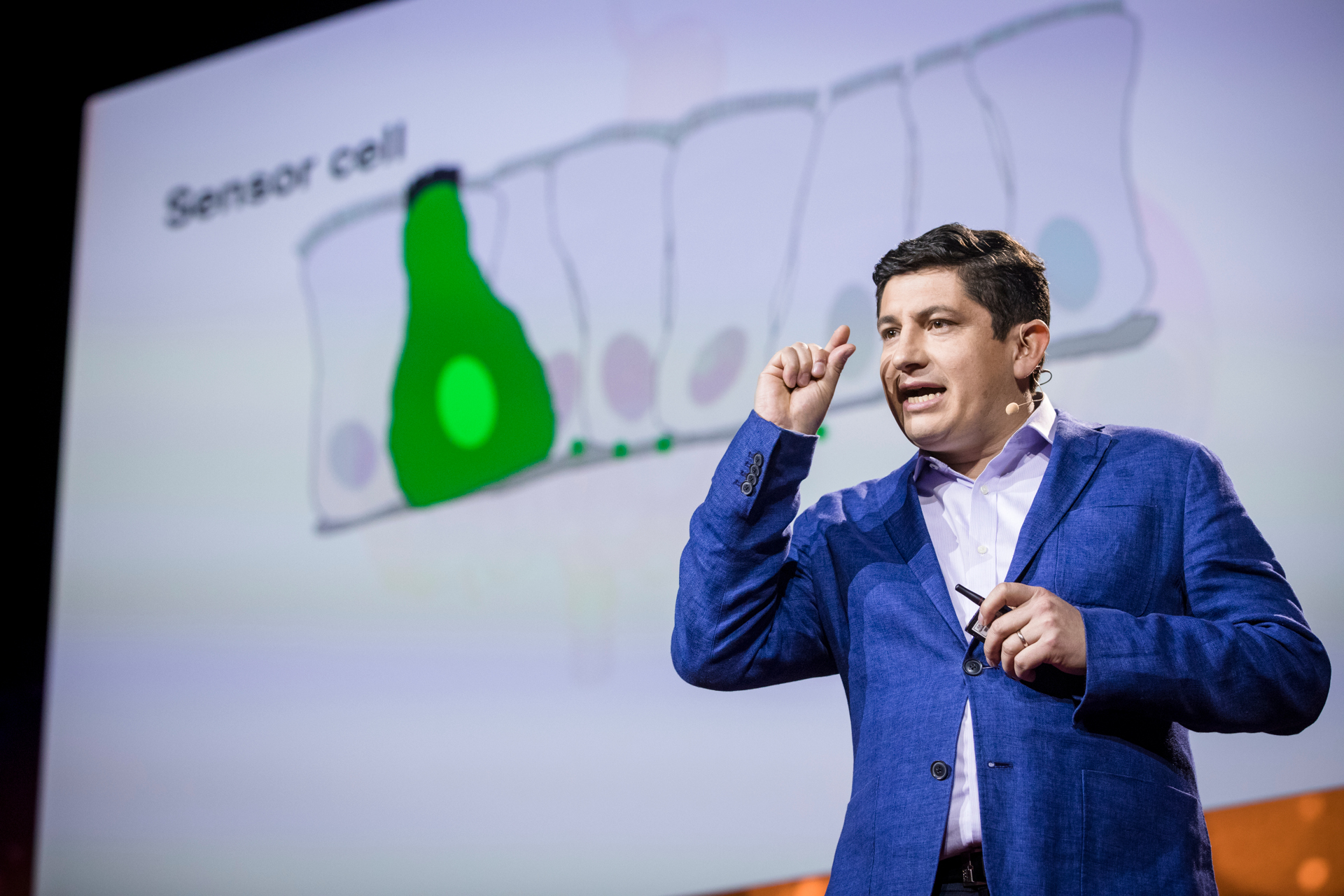
Every we learn more and more about the cells in our gut. Diego Bohorquez shares a recent discovery about how gut cells can smell, taste and even “touch” foods. He speaks at TED2017, April 24, 2017, Vancouver, BC, Canada. Photo: Ryan Lash / TED
Did you know that the cells that line your gut can smell, taste and touch foods, using the same molecular receptors used by your nose, tongue and hands? Until now, it’s been thought that enderoendocrine cells – which Ecuadorian neuroscientist Diego Bohorquez calls gut sensors – communicated information to the brain via hormone signaling. But his recent studies are making us rethink how these cells interact with the body’s nervous system. After studying sensor cells for seven years using molecular tools, Bohroquez has discovered that they have a unique arm called a neuropod – a protrusion that appears to be able to make direct physical contact with neurons. In other words, communication might not be mediated through hormones but by forming a synapse – the difference between communicating via email and a handshake. This has implications for understanding how pathogens might pass from the gut to the brain, how our guts affect our dietary cravings, and might help us understand how we might use nutrients to treat the brain directly from the gut.
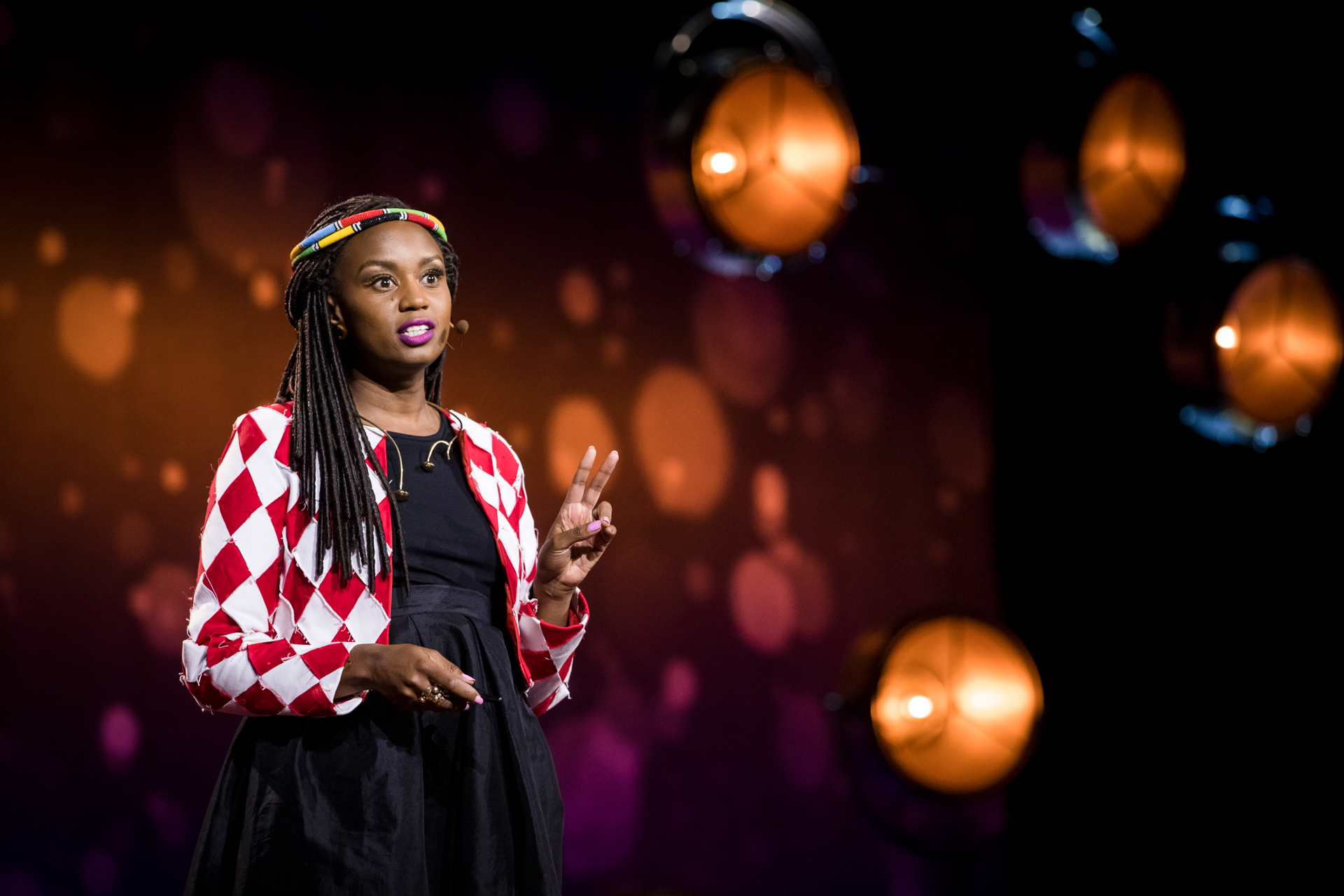
Wanuri Kahlu proposes a new rule for art about Africa — to step away from the over-serious focus and tell more than a single story. She speaks at TED2017, April 24, 2017, Vancouver, BC, Canada. Photo: Ryan Lash / TED
Kenyan filmmaker Wanuri Kahiu thinks that too much art in Africa has a political agenda – and what’s missing is art for art’s sake. So she proposes a new lens through which to view the continent: Afrobubblegum – “Fun, fierce and frivolous art in the name of all that is un-seriously African,” she says. “We’re so used to narratives out of Africa being about war, famine and suffering,” she says. “Where is the fun?” In her own films, she uses science fiction and fantasy to tell modern African stories – stories about Nairobi bands that want to go to space, about robots that fall in love, about girls who race camels or just want to dance. That’s not to say that Kahiu thinks issue-driven African art should go away – her first feature film From a Whisper covers the twin bombings of US embassies in Kenya and Tanzania, for example. But Kahuri cautions that telling a single story about an entire continent is dangerous: “We should ask, are two or more Africans in this story healthy, not in poverty or need saving? Are they thriving, loving, enjoying life to the full? If we see such stories, will we think we are worthy of more happiness?”
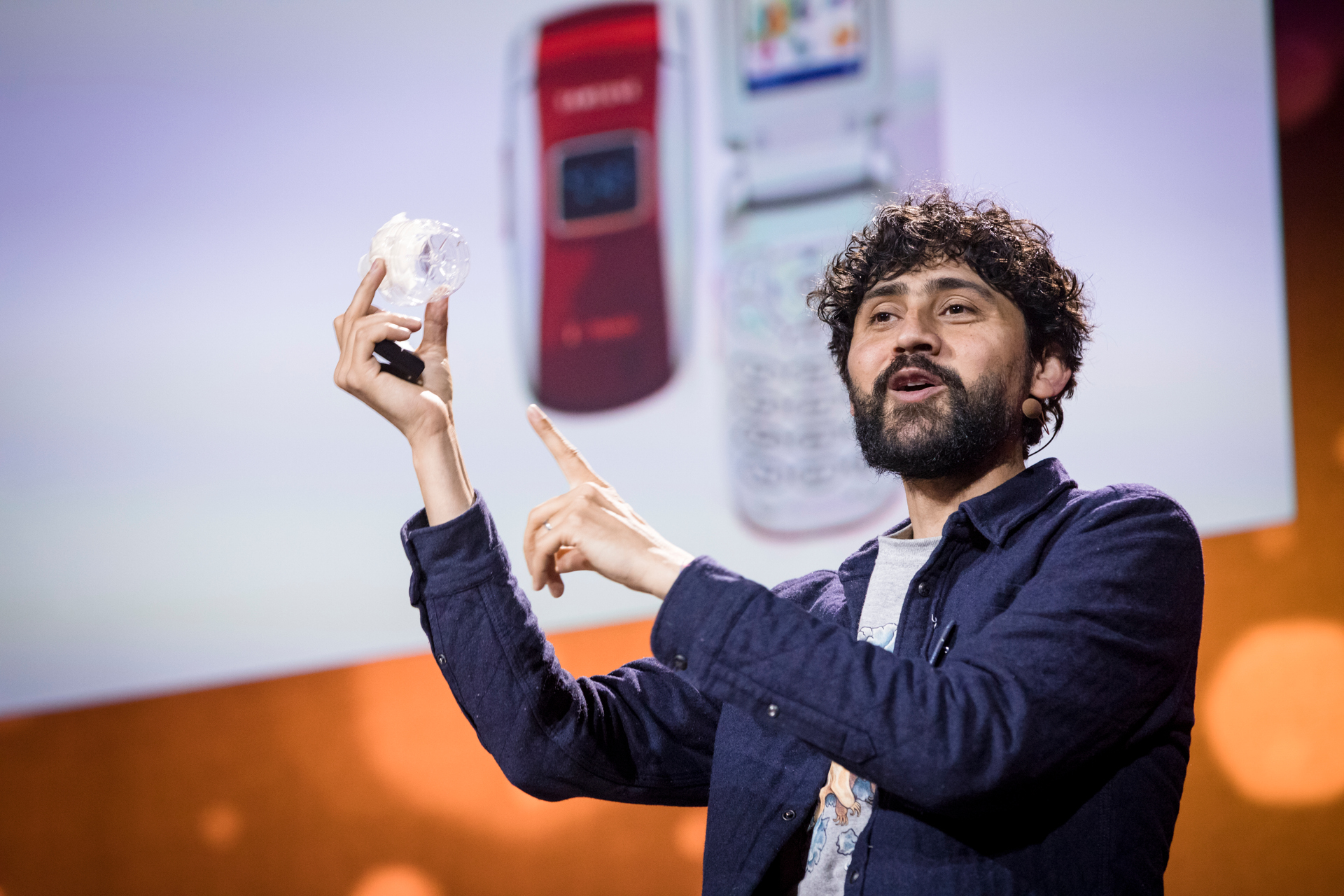
Manu Prakash demos one of his cheap-and-cheerful inventions that allow people to do science for pennies. He speaks at TED2017, April 24, 2017, Vancouver, BC, Canada. Photo: Ryan Lash / TED
For inventor Manu Prakash, “frugal science” means creating affordable scientific tools that allow as many people in the world as possible to have the “Oh my god” moment – that spark of wonder and curiosity leading to a sense of empowerment to solve problems. The inventor of the Foldscope has already deployed 50,000 paper microscopes across 130 countries, building a community of people around the world who are sharing their discoveries online. Today, on the TED Fellows stage, Prakash introduces two more of his Stanford lab’s low-cost scientific tools. The first, a 20-cent paper centrifuge, is based on one of the world’s oldest known toy, the whirligig. Centrifuges are critical tools for diagnosing such diseases as anemia, malaria, HIV and tuberculosis; Prakash’s paper centrifuge uses the g-forces of the toy to separate blood cells from plasma, allowing health care workers to diagnose diseases in remote areas where such tools are most needed. More recently, he’s figuring out how to record the buzz of mosquitos with cell phones and upload the acoustic signature to a database, making it possible to identify mosquito species and map their location in real time – valuable information that could help prevent the spread of vector-borne diseases like Zika and malaria.
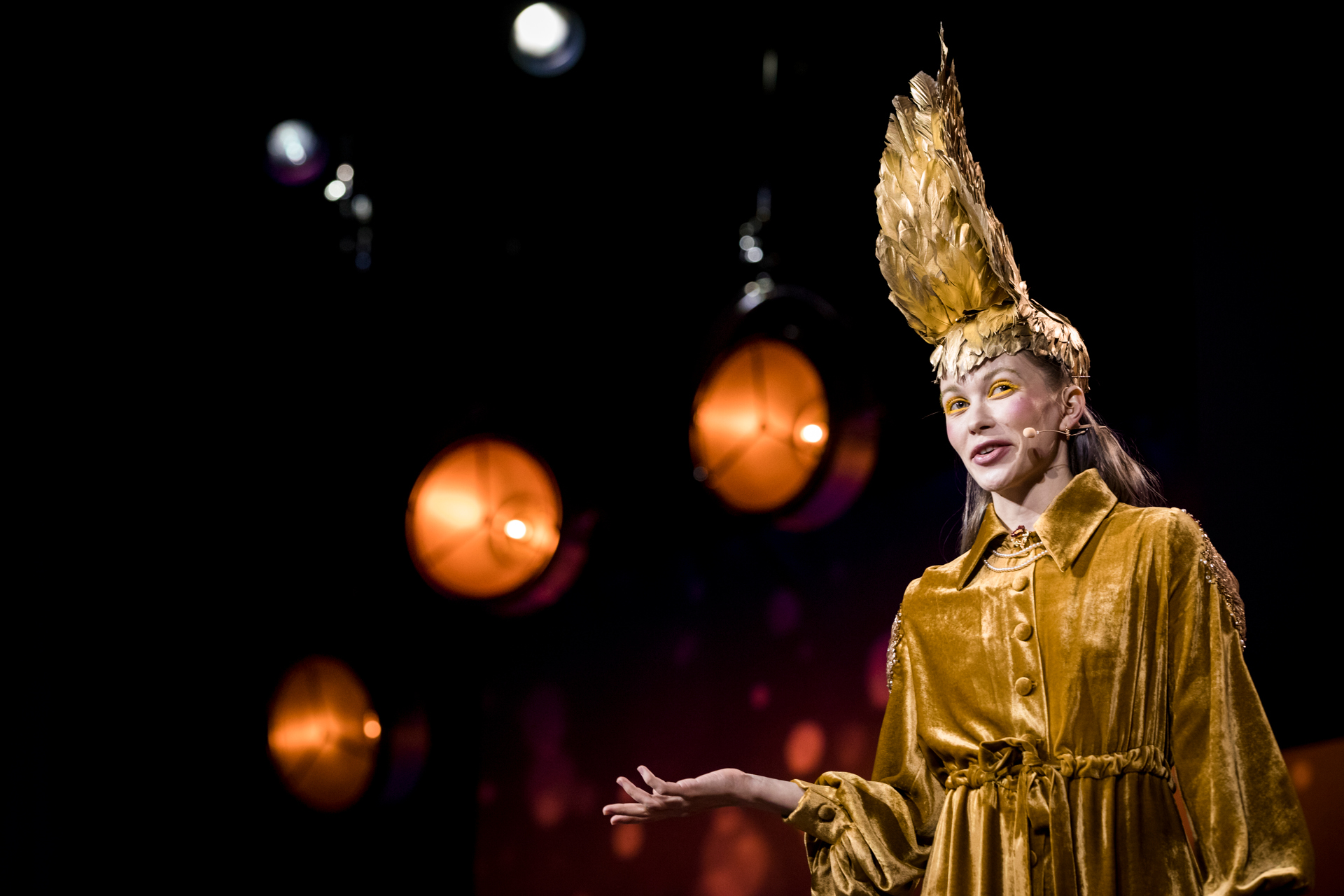
For her gorgeous photos, TED Senior Fellow Uldus Bakhtiozina creates costumes and sets and elaborate characters that build a fantasy world full of authentic detail. She speaks and shows her work at TED2017, April 24, 2017, Vancouver, BC, Canada. Photo: Ryan Lash / TED
When Russian artist Uldus Bakhtiozina found herself in London, making ends meet by working as a waitress, she made life bearable by creating the character of a waitress, and pretended to be playing the character in a film. Now, as an artist, she invites the subjects of her elaborate photographs to play the same game: creating a fantasy life for them to occupy. She hand-creates sets, costumes, and even effects – nothing in her images is digitized. In other words, everything in this fantasy world takes place in reality, and part of the beauty of the process is the authenticity of making. Uldus works with people who live with adversity – such as one young woman whose health prevented her from being an athlete. Uldus photographed her as the warrior she wanted to be, and the image was exhibited in Milan to thousands of people, just before her death at the age of 22 of heart disease. “Reincarnation gives us the very real feeling of being important and powerful to influence our reality,” says Uldus.
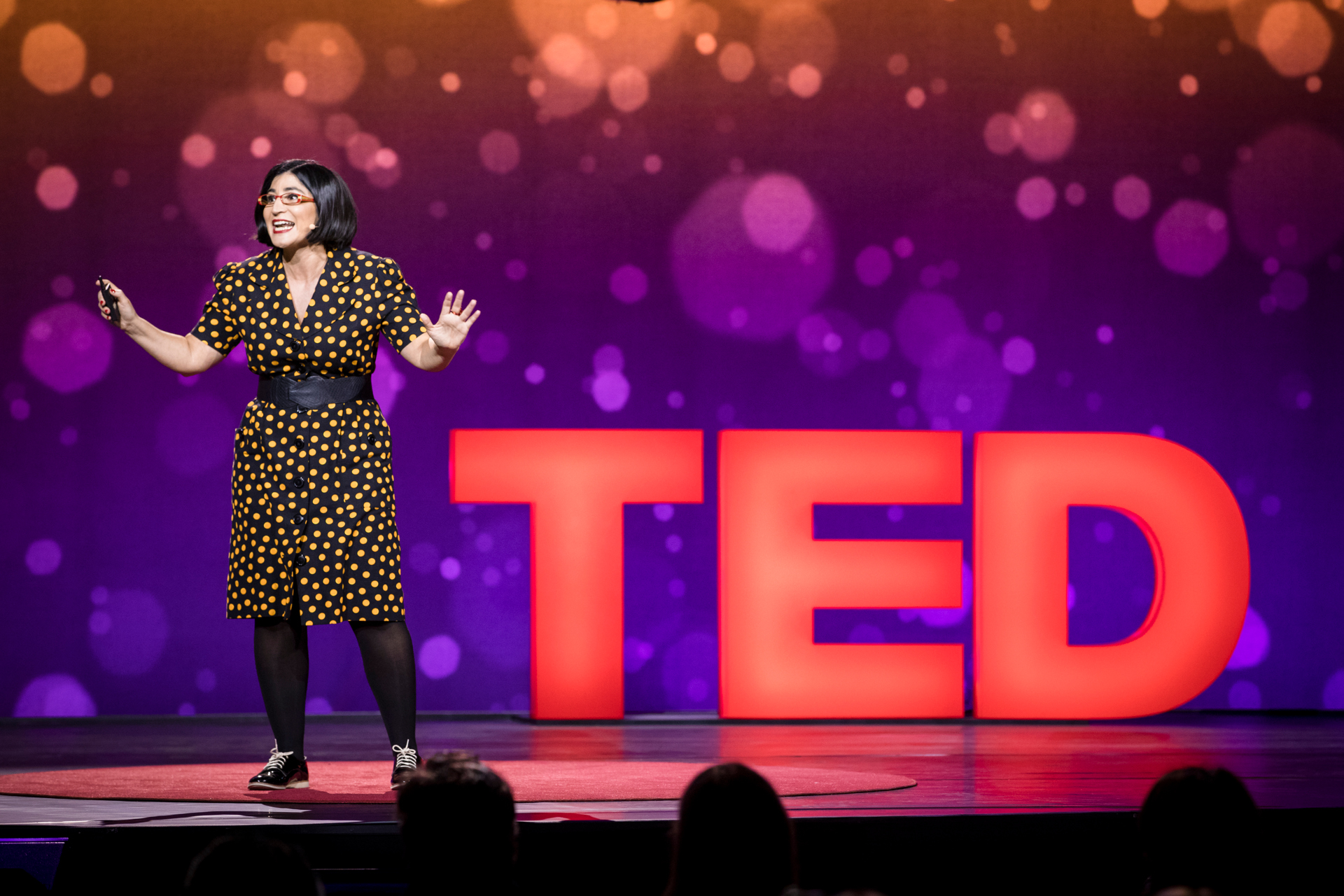
Senior Fellow Negin Farsad shares her not-so-serious but also serious tips for fighting bigotry, stereotypes and agendas of hate. She speaks at TED2017, April 24, 2017, Vancouver, BC, Canada. Photo: Ryan Lash / TED
It’s not always easy to take our current president with a sense of humor, as Iranian-American comedian Negin Farsad knows. But she gives it a go. Here, a few rules of thumb for How to Make Jokes at a Tyrant – aka Rules for Schmyrants:
- Never use their real name. Call him instead, say, “popular-vote-losing minority president Donny Twiimp.” At a loss? Visit Donnytwimp.com to access an exhaustive database of alternate names.
- Undermine their stereotypes. For example, “Muslims: totally obsessed with Pop Tarts.” “Mexicans: annoyingly good at astrobiology.” “Women have blood coming out of their PhDs.” For more, visit Twitter bot @altstereotypes. Repeat aggressively.
- Flip the script on the Baby Schmyrants – you know, the trolls who insist on calling you a Jewy McJewface when you are clearly a Muslim. Don’t fight. Just respond with a smiley face. “When they go low, we go emoji.”
- Hit ’em in the coin purse. Taking a stand against Twimp’s agenda of hate, Farsad and her comedy partner Dean Obeidallah have launched the Boycotting Bigotry campaign, calling for boycotts of Trump interests, including his golf courses in Florida.
- And finally, because nothing sucks the life force out of a schmyrant like seeing you have a good time: “Do all these things with a smile and wink. Have fun, because they hate that.”